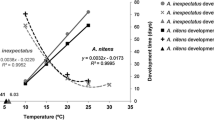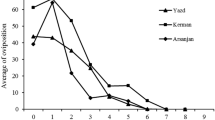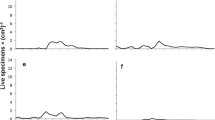Abstract
Despite the release of about 1.9 million individuals of Pareuchaetes insulata (Walker) (Lepidoptera: Erebidae) in KwaZulu-Natal for the biological control of Chromolaena odorata (L.) King and Robinson (Asteraceae) in South Africa, the moth probably only established at one of the 30 release sites and its population level is generally low in the field. To determine whether climate incompatibility in South Africa is responsible for the poor performance of P. insulata, the effects of temperature on life-history traits were investigated under several constant temperatures. Although a degree-day model estimated between 3.9 and 10.0 generations of the moth per year in the weed’s invaded range, survival and fecundity declined while development time was prolonged at constant temperatures below 25 °C, indicating that both direct and indirect negative impacts of low winter temperatures, such as increased mortality, slow development and reduced fecundity as well as exposure to natural enemies, may partly explain the poor performance of P. insulata in South Africa.


Similar content being viewed by others
References
Bergelson JM, Lawton JH (1988) Does foliage damage influence predation on the insect herbivore of birch? Ecology 69:434–445
Bernays EA (1997) Feeding by lepidopteran larvae is dangerous. Ecol Entomol 22:121–123
Campbell A, Frazer BD, Gilbert N, Gutierrez AP, Mackauer M (1974) Temperature requirements of some aphids and their parasites. J Appl Ecol 11:431–438
Chown SL, Nicholson SW (2004) Insect physiological ecology: mechanisms and patterns. Oxford University Press, New York
Chown SL, Terblanche JS (2006) Physiological diversity in insects: ecological and evolutionary contexts. Adv Insect Physiol 33:50–152
Clissold FJ, Sanson GD, Read J (2006) The paradoxical effects of nutrient ratios and supply rates on outbreaking insect herbivore, the Australian plague locust. J Anim Ecol 75:1000–1013
Coetzee JA, Byrne MJ, Hill MP (2007) Predicting the distribution of Eccritotarsus catarinensis, a natural enemy released on water hyacinth in South Africa. Entomol Exp Appl 125:237–247
Dhileepan K, Taylor DBJ, McCarthy J, King A, Shabbir A (2013) Development of cat’s claw creeper leaf-tying moth Hypocosmia pyrochroma (Lepidoptera: Pyralidae) at different temperatures: implications for establishment as a biological control agent in Australia and South Africa. Biol Control 67:194–202
Diamond SE, Kingsolver JG (2010) Environmental dependence of thermal reaction norms: host plant quality can reverse the temperature-size rule. Am Nat 175:1–10
Esterhuizen N, Clusella-Trullas S, van Daalen CE, Schoombie RE, Boardman L, Terblanche JS (2014) Effects of within-generation thermal history on the flight performance of Ceratitis capitata: colder is better. J Exp Biol 217:3545–3556
Feeny P, Blau WS, Kareiva PM (1985) Larval growth and survivorship of the black swallowtail butterfly in central New York. Ecol Monogr 55:167–187
Hochachka PW, Somero GN (2002) Mechanisms and processes in physiological evolution. Oxford University Press, New York
Hough-Goldstein J, Lake EC, Shropshire KJ, Moore RA, D’Amico V (2016) Laboratory and field-based temperature-dependent development of a monophagous weevil: implications for integrated weed management. Biol Control 92:120–127
Ikemoto T, Takai K (2000) A new linearised formula for the law of total effective temperature and the evaluation for line fitting methods with both variables subject to error. Environ Entomol 29:671–682
Kleynhans E, Conlong DE, Terblanche JS (2014) Host plant-related variation in thermal tolerance of Eldana saccharina (Lepidoptera: Pyralidae). Entomol Exp Appl 150:113–122
Kriticos DJ, Maywald GF, Yonow T, Zurcher EJ, Herrmann NI, Sutherst RW (2015) CLIMEX version 4: exploring the effects of climate on plants, animals and diseases. CSIRO, Canberra
Leslie AJ, Spotila JR (2001) Alien plant threatens Nile crocodile (Crocodylus niloticus) breeding in Lake St. Lucia, South Africa. Biol Conserv 98:347–355
May B, Coetzee J (2013) Comparisons of the thermal physiology of water hyacinth biological control agents: predicting establishment and distribution pre- and post-release. Entomol Exp Appl 147:241–250
McClay AS (1996) Biological control in a cold climate: temperature responses and climatic adaptation of weed biocontrol agents. In: Moran VC, Hoffman JH (eds) Proceedings of the ninth international symposium on biological control of weeds. University of Cape Town, Cape Town, South Africa, pp 377–383
McClay AS, Hughes RB (1995) Effects of temperature on developmental rate, distribution, and establishment of Calophasia lunula (Lepidoptera: Noctuidae), a biocontrol agent for toadflax (Linaria spp.). Biol Control 5:368–377
Rice WR (1989) Analyzing tables of statistical tests. Evolution 43:223–225
Southwood TRE, Henderson PA (2000) Ecological methods, 3rd edn. Blackwell Science, Oxford
Strathie LW, Zachariades C (2014) Unexpected spread and outbreaks of Pareuchaetes insulata, the defoliating moth on Chromolaena odorata, in northern KwaZulu-Natal. Plant Prot News 101:10–11
Tamiru A, Getu E, Jembere B, Bruce T (2012) Effect of temperature and relative humidity of the development and fecundity of Chilo partellus (Swinhoe) (Lepidoptera: Crambidae). Bull Entomol Res 102:9–15
Terblanche JS (2013) Thermal relations. In: Chapman RF, Simpson SJ, Douglas AE (eds) The insects: structure and function, 5th edn. Cambridge University Press, Cambridge, pp 588–621
Uyi OO (2014) Aspects of the biology, thermal physiology and nutritional ecology of Pareuchaetes insulata (Walker) (Lepidoptera: Erebidae: Arctiinae), a specialist herbivore introduced into South Africa for the biological control of Chromolaena odorata (L.) King and Robinson (Asteraceae) Ph.D thesis. Rhodes University, Grahamstown, South Africa
Uyi OO, Hill MP, Zachariades C (2014a) Variation in host plant has no effect on the performance and fitness-related traits of the specialist herbivore Pareuchaetes insulata. Entomol Exp Appl 153:64–75
Uyi OO, Zachariades C, Hill MP (2014b) The life history traits of the arctiine moth Pareuchaetes insulata, a biological control agent of Chromolaena odorata in South Africa. Afr Entomol 22:611–624
Uyi OO, Zachariades C, Hill MP (2016) Nitrogen fertilization improves growth of Chromolaena odorata (Asteraceae) and the performance of the biological control agent, Pareuchaetes insulata (Erebidae). Biocontrol Sci Technol 26:373–385
Visalakshy PNG (1998) Temperature dependent development of Pareuchaetes pseudoinsulata (Lepidoptera: Arctiidae), an exotic biocontrol agent of Chromolaena odorata. In: Ferrar P, Muniappan R, Jayanth KP (eds) Proceedings of the fourth international workshop on the biological control and management of Chromolaena odorata. Publication 216. Agricultural Experiment Station, University of Guam, Guam, USA, pp 102–104
Watt T, Duan JJ, Tallamy DW, Hough-Goldstein J, Ilvento TW, Yue X, Ren H (2016) Reproductive and developmental biology of the emerald ash borer parasitoid Spathius galinae (Hymenoptera: Braconidae) as affected by temperature. Biol Control 96:1–7
Wu L, Wang C, Wu W (2013) Effects of temperature and adult nutrition on the development of Acanthoscelides macrophthalmus, a natural enemy of an invasive tree, Leucaena leucocephala. Biol Control 65:322–329
Yoder JA, Chambers MJ, Tank JL, Keeney GD (2009) High temperature effects on water loss and survival examining the hardiness of female adults of the spider beetles, Mezium affine and Gibbium aequinoctiale. J Insect Sci 9:68
Zachariades C, Day M, Muniappan R, Reddy GVP (2009) Chromolaena odorata (L.) King and Robinson (Asteraceae). In: Muniappan R, Reddy GVP, Raman A (eds) Biological control of tropical weeds using arthropods. Cambridge University Press, Cambridge, UK, pp 130–160
Zachariades C, Strathie LW, Retief E, Dube N (2011) Progress towards the biological control of Chromolaena odorata (L.) R.M. King and H. Rob. (Asteraceae) in South Africa. Afr Entomol 19:282–302
Acknowledgments
The authors thank the Department of Environmental Affairs: Natural Resource Management Programmes and ARC-Plant Protection Research Institute, South Africa for providing funding and facilities. The financial support given to the first author by the German Academic Exchange Service (DAAD) is acknowledged. Thanks to Sappi Forests (Mr Pemberayi Nyamande) for permission to place iButtons within Cannonbrae plantation. The South African Weather Services is thanked for providing climate data across the distribution range of C. odorata in South Africa. We thank Mr. Osaro Igbinosa of the Department of Mathematics, University of Benin, Benin City, Nigeria, for statistical advice.
Author information
Authors and Affiliations
Corresponding author
Additional information
Handling Editor: S. Raghu.
Rights and permissions
About this article
Cite this article
Uyi, O.O., Zachariades, C., Hill, M.P. et al. Temperature-dependent performance and potential distribution of Pareuchaetes insulata, a biological control agent of Chromolaena odorata in South Africa. BioControl 61, 815–825 (2016). https://doi.org/10.1007/s10526-016-9760-1
Received:
Accepted:
Published:
Issue Date:
DOI: https://doi.org/10.1007/s10526-016-9760-1




